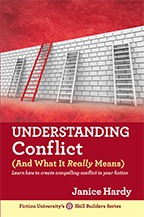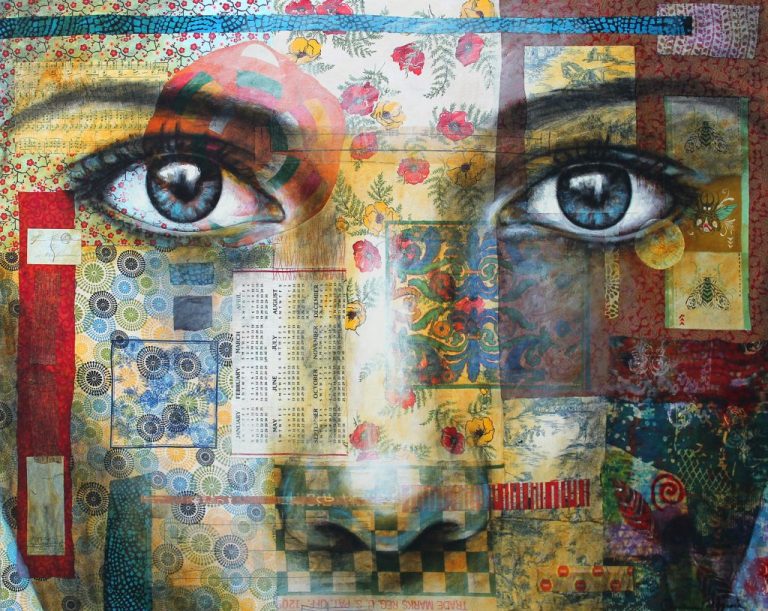5 Ways to Create Strong Internal Conflict
Today’s guest post is by author Janice Hardy.
Internal conflicts and character arcs are so intertwined, many writers think they’re the same thing—but they’re not. The character arc just uses an internal conflict (as well as the external conflict) to bring about the character’s change. A story can have internal conflict without a character arc and still be a strong story.
Internal conflicts are simply the emotional, ethical, or mental struggles a character faces while trying to decide what to do about an external problem (the goals that make up the plot). The challenge isn’t a physical thing in the way but a struggle within the protagonist to make the right choice.
In essence, it’s the mental and emotional debate the protagonist needs to have in order to resolve an external problem.
Why Are Internal Conflicts Useful?
An external task that’s easy to complete often lacks tension and unpredictability, which leads to boring stories. But that same task can become interesting by adding an emotional roadblock.
What needs to be done is clear, but the protagonist doesn’t want to resolve it that way for personal reasons. Either the right choice has consequences she doesn’t want to suffer, or there is no good choice—whatever she does has serious ramifications.
Internal conflicts are based on who the protagonist is and what has happened to her in her life, and this past makes it harder for her to make decisions and resolve her external challenges. They typically come from the morals and ethics of the character, and, more often than not, choosing one side negates the other, and the protagonist can’t have it both ways.
Here are five ways you can add internal conflict:
- Make a character contradict her belief system
What a character thinks is true affects her behavior. If the right choice contradicts what the protagonist “knows” is true, she probably won’t choose it. At the very least, she’ll struggle and do some serious soul searching to resolve that conflict and make that choice.
For example, a woman who has been badly mistreated by men her entire life will very likely believe that all men are bad people not to be trusted. So if she has to make a decision based on trusting a man, there’s a good chance she’ll have trouble making it. Forcing your character to go against a strong-held belief to get what she wants can create a lot of fun conflict to play with in a novel.
- Make a character act against her morality and ethics
How a character believes other people should be treated will also affect how she makes a decision—and sometimes these are much harder to reconcile. For example, if the protagonist believes killing is wrong, any choice that requires killing someone (or even killing an animal) will be met with fierce resistance.
The character’s morality is rooted in her personal rules and laws of acceptable behavior. But if killing is the only way to save someone she loves, or prevent something terrible from happening, she might be tempted. Doing a bad thing for a greater good can be a persuasive argument—and a very slippery slope to disaster.
- Give a character a crisis of conscience
Sometimes a character wants to do things she knows are wrong. For example, it might be a minor transgression, such as lying to a friend to get out of going somewhere when she’s tired and wants to stay home, or a major breach of ethics, such as stealing from her employer because he cheated her out of a promised bonus. What she wants to do goes against what she knows is right, and she’s doing her best to rationalize why it’s okay to do it anyway. Such ethical slipups can be compelling problems for your protagonist to regret and have to deal with at the worst possible time in the story.
- Let a character’s fear sway her better judgment
Even the best person can act badly out of fear. If a character is focused on survival or avoiding a terrible fate, she might make bad decisions or go against her morality. For example, a character might stay quiet about a belief and not stand up for someone being mistreated out of fear she’ll be attacked in turn. Or, she might lie or agree to something she knows is wrong to keep something of value to her (such as a job). Being too afraid to do the right thing is a conflict nearly everyone can relate to.
- Embarrass or shame a character into making a bad decision
Shame is a powerful emotion. People can ignore their ethics and personal beliefs if it means saving themselves from a terrible secret being revealed. (Think back to middle school or high school.) They’ll act to avoid standing out or looking foolish, which can keep them from doing the right thing at the right time to prevent a problem. Someone who witnessed a crime while doing something embarrassing isn’t likely to tell anyone for fear his own transgression will be exposed.
Internal conflicts are fun opportunities to put the protagonist in the hot seat and force him to decide who he is and what he stands for. How far is he willing to go to help a friend? What will he risk? What does he value? His struggles while making a decision shows readers who he really is as a person.
What does your protagonist struggle with? What are some of your favorite characters’ internal conflicts? Share in the comments!
 Looking for more tips on creating conflict? Check out my latest book Understanding Conflict (And What It Really Means), an in-depth guide to how to use conflict in your fiction.
Looking for more tips on creating conflict? Check out my latest book Understanding Conflict (And What It Really Means), an in-depth guide to how to use conflict in your fiction.
 Janice Hardy is the award-winning author of the fantasy trilogy, The Healing Wars, and multiple books on writing, including Understanding Show, Don’t Tell (And Really Getting It), Planning Your Novel: Ideas and Structure and Revising Your Novel: First Draft to Finished Draft. She’s also the founder of the writing site Fiction University. Follow Janice on Twitter.
Janice Hardy is the award-winning author of the fantasy trilogy, The Healing Wars, and multiple books on writing, including Understanding Show, Don’t Tell (And Really Getting It), Planning Your Novel: Ideas and Structure and Revising Your Novel: First Draft to Finished Draft. She’s also the founder of the writing site Fiction University. Follow Janice on Twitter.












Thanks so much for having me!
An excellent post, Janice! Very clear and concise. Sharing. 🙂
Thanks! Glad you liked it.
Awesome post. Very helpful.
Hi Janice,
I’m so glad I stopped by today. I actually ordered your new book yesterday, and now I’m even more excited about it.
You just saved a life Janice! I absolutely love this post;-) Thank you!